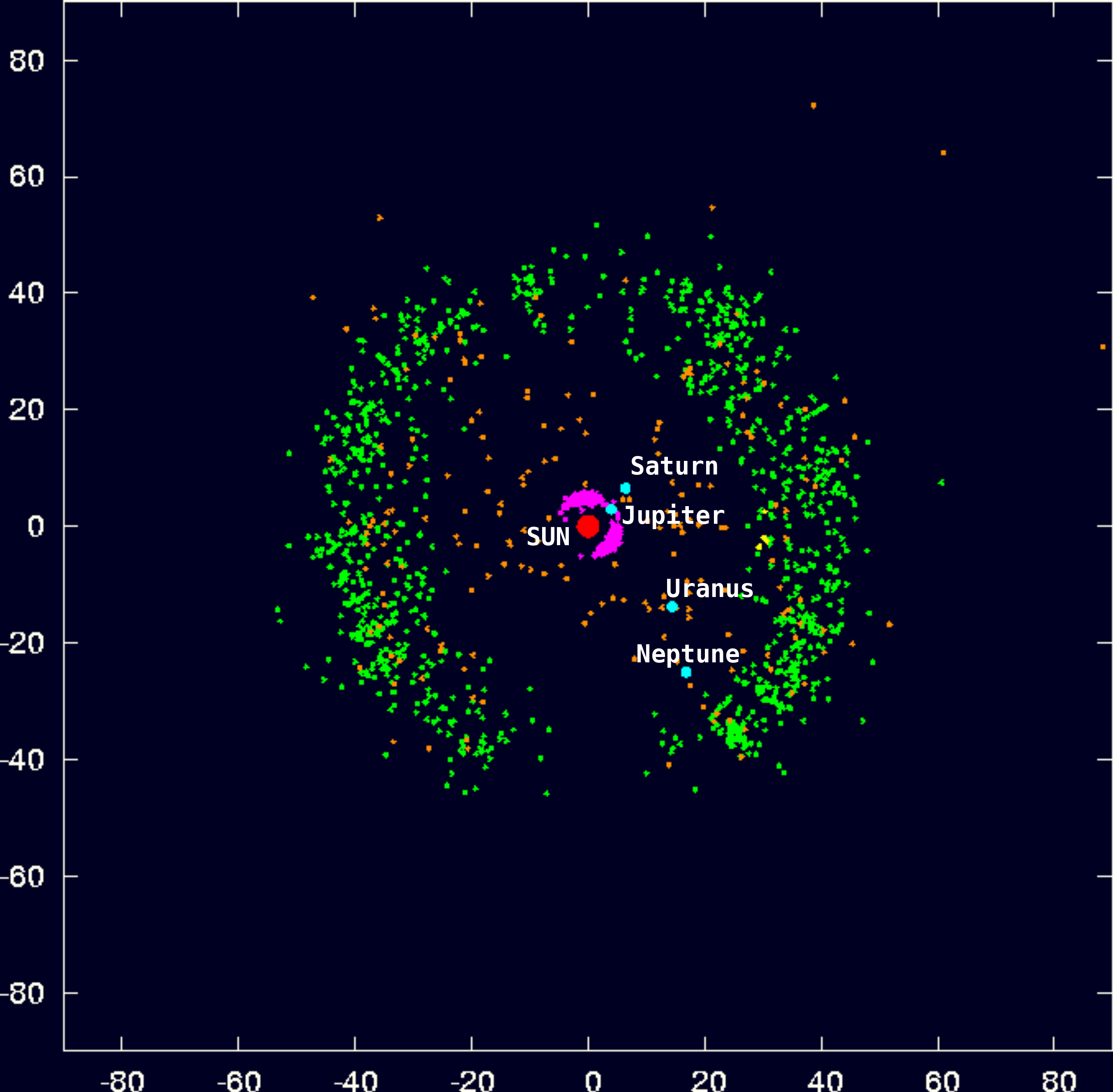SOLAR SYSTEM


The Solar System consists of the Sun and those celestial objects bound to it by gravity, all of which formed from the collapse of a giant molecular cloud approximately 4.6 billion years ago. Of the retinue of objects that orbit the Sun, most of the mass is contained within eight relatively solitary planets whose orbits are almost circular and contained within a nearly-flat disc called the ecliptic plane. The four smaller inner planets; Mercury, Venus, Earth and Mars, also called the terrestrial planets, are primarily composed of rock and metal. The four outer planets, Jupiter, Saturn, Uranus and Neptune, also called the gas giants, are composed largely of hydrogen and helium and are far more massive than the terrestrials.
Inner Solar System (Asteroid Belt)

The Solar System is also home to two regions populated by smaller objects. The asteroid belt, which lies between Mars and Jupiter, is similar to the terrestrial planets as it is composed mainly of rock and metal. Between 2.3 and 3.3 AU from the Sun. It is thought to be remnants from the Solar System's formation that failed to coalesce because of the gravitational interference of Jupiter.
Asteroids range in size from hundreds of kilometres across to microscopic. All asteroids save the largest, Ceres, are classified as small Solar System bodies, but some asteroids such as Vesta and Hygieia may be reclassed as dwarf planets if they are shown to have achieved hydrostatic equilibrium.
Outer Solar System (Kuiper Belt)

The Kuiper belt is a region of the Solar System beyond the planets extending from the orbit of Neptune (at 30 AU) to approximately 55 AU from the Sun. It is similar to the asteroid belt, although it is far larger—20 times as wide and 20–200 times as massive. Like the asteroid belt, it consists mainly of small bodies, or remnants from the Solar System's formation. While the asteroid belt is composed primarily of rock and metal, the Kuiper belt objects are composed largely of frozen volatiles (termed "ices"), such as methane, ammonia and water. It is home to at least three dwarf planets – Pluto, Haumea and Makemake.
The Kuiper belt should not be confused with the hypothesized Oort cloud, which is a thousand times more distant. The objects within the Kuiper belt, together with the members of the scattered disc and any potential Hills cloud or Oort cloud objects, are collectively referred to as trans-Neptunian objects (TNOs).

Inner Solar System, Outer Solar System, Orbit of Sedna, and Oort Cloud
Beyond Neptune's orbit lie trans-Neptunian objects (TNOs) composed mostly of ices such as water, ammonia and methane. Within these regions, five individual objects, Ceres, Pluto, Haumea, Makemake and Eris, are recognised to be large enough to have been rounded by their own gravity, and are thus termed dwarf planets. In addition to thousands of small bodies in those two regions, various other small body populations, such as comets, centaurs and interplanetary dust, freely travel between regions.
90377 Sedna is a trans-Neptunian object and a likely dwarf planet. It is currently 88 AU from the Sun, about three times as distant as Neptune. Sedna has a highly elliptical orbit, with its aphelion estimated at 975 AU and its perihelion at about 76.16 AU. It was the most distant object in the solar system yet observed.
Trans-Neptunian objects (TNOs) are classified in two large groups
1.
The Kuiper belt contains objects with an average distance to the sun of
30 to about 55 AU, usually having close-to-circular orbits with a small
inclination from the ecliptic. Kuiper belt objects are further
classified into the following two groups.• Resonant objects are locked in an orbital resonance with Neptune. Objects with a 1:2 resonance are also called twotinos, and objects with a 2:3 resonance are called plutinos, after their most prominent member, Pluto.
• Classical Kuiper belt objects (also called cubewanos) have no such resonance, moving on almost circular orbits, unperturbed by Neptune. Examples are 1992 QB1, 50000 Quaoar and Makemake.
2. The scattered disk contains objects further from the Sun, usually with very irregular orbits (i.e. very elliptical and having a strong inclination from the ecliptic). A typical example is the largest known TNO, Eris.
OBLIQUITY OF THE EIGHT PLANETS
Obliquity is the angle between a planet's equatorial plane and its orbital plane.

| Obliquity | Rotation Period (hrs) | |
|---|---|---|
| Mercury | 0.1° | 1407.5 |
| Venus | 177.4° | 5832.5 |
| Earth | 23.45° | 23.9345 |
| Mars | 25.19° | 24.623 |
| Jupiter | 3.12° | 9.925 |
| Saturn | 26.73° | 10.656 |
| Uranus | 97.86° | 17.24 |
| Neptune | 29.56° |
16.11
|
No comments:
Post a Comment
Note: Only a member of this blog may post a comment.